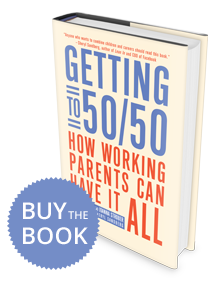Reinventing the Workplace
By Sharon Meers and Joanna Strober
washingtonpost.com
September 5, 2006
Protests over work hours gave us Labor Day in 1894. Americans have re-invented the workplace many times since and it's time to do it again. Census data shows that 60 percent of married couples have been dual-career for over 15 years. Yet most employers design jobs as if all employees had an at-home spouse. This assumption is hurting our country and our economy.
Two incomes provide a safety net and stability. Research group Catalyst reports that dual-earner couples more readily take chances in their careers. As one man said of his wife, "She made enough that I was able to do something far more entrepreneurial than I would have if we were relying on one income." In a world of rapid innovation, our country wins when families can keep themselves afloat and take the risks required to find better jobs.
The gains go beyond economics: Women and men have better health when they're engaged in both work and family. Data has long shown that married, working mothers enjoy better physical health and less incidence of depression than mothers who aren't employed. For fathers, the results are parallel: Men with the highest well-being are the ones most involved with their children.
When both spouses work, children do well, too. In the most comprehensive study of U.S. childcare, the National Institute of Child Health and Human Development found facts such as this: Kids in two-income families score the same (on skills and behavior) as those with full maternal care. Children, themselves, report they're content: 67 percent of kids in dual-career homes say they get enough parental time, precisely the same percentage as kids with an at-home mom, according to the Families and Work Institute.
Practical changes help dual-career families. Large employers as diverse as Google and the U.S. military have found on-site childcare cost effective. Tax credits for dependent care can be increased above the current $5,000 cap. Workdays can be made shorter, more flexible and more efficient so parents can see their kids without hurting profits. But the biggest obstacle is a lingering attitude that moms belong at home, and that a single-earner family is a sign of social status. "I'm so glad I make enough money that my wife stays home," a proud executive told us. Employer childcare, tax breaks and efficient hours won't become common while that attitude remains. Dual-career homes make our workforce agile and our country dynamic, while allowing parents and kids to thrive. In honor of this Labor Day, let's give two-income families the status they're due and start adapting our workplaces to reflect today's reality.
Sharon Meers was a managing director at Goldman Sachs in San Francisco until last year when she left to create the Partnership for Parity at Stanford University, focused on workplace reform. Co-author Joanna Strober is a private equity investor. Their upcoming book, "Opting In," focuses on workplace reform and employee negotiation that allow dads to be full parents and moms to have full careers, based on their research on dual-earner couples. Meers and Strober both live in the San Francisco bay area with their husbands and children.

